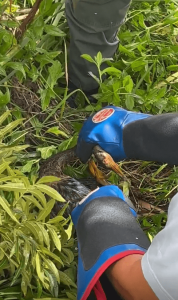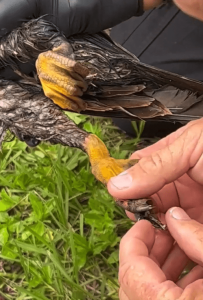Nature has a way of captivating our hearts, of inspiring us with beauty, strength, persistence and more. When we look more closely at those moments, we’re often reminded of the delicate balance that exists within our ecosystems, and how our actions can have big repercussions.
Recently, we encountered just such a reminder, one involving discarded fishing line and hooks.
Fishing is immensely popular in our area, and the vast majority of those who fish take care to properly dispose of their used or broken lines, to recover and stow hooks, lures, and other gear. But it takes just one carelessly tossed line to entangle a bird or other animal, one hook left snagged on a small tree limb or bush to injure an animal.
That was the reminder we had, when a colleague walking around one of the lakes at Twin Lakes Park spotted a young anhinga snarled in fishing line, helplessly hanging upside down from a tree branch over the water. Occasionally, the bird would muster the strength to frantically flap its wings to free itself. Each time, though, it remained stuck. Without help, disaster awaited the anhinga.
An Impossible Reach
Making matters worse, the anhinga was stuck on a branch that hung precariously over the lake, its treacherous position leaving no accessible route to assist the distressed bird. Realizing the urgency of the situation, wildlife rescue was called. Luckily, they happened to be in the vicinity and quickly made their way to Twin Lakes Park.
An officer from Sarasota County Animal Services and two deputies with the Sarasota County Sheriff’s Office Agriculture Unit responded. They happened to be nearby, and quickly made it to Twin Lakes Park.
After carefully assessing the situation, they decided to cut the branch to free the anhinga from its tangled state. This decision was not taken lightly, as these professionals understood the impact it might have on an already injured bird.
Armed with specialized tools and wearing protective gear, the rescue team worked to free the anhinga. They cut the branch, and then quickly pulled the bird from the water. A close inspection, then, revealed that fishing line had wrapped around the anhinga’s beak. And, that line was attached to a discarded hook that was now deeply embedded in the bird’s foot.
The rescue team quickly removed the fishing line from the anhinga’s beak. But the hook in her foot proved more of a problem. The rescue team did what they could for the bird on site, then carefully placed her in a carrier and transported her to the Wildlife Center in Venice.
When last we heard, our anhinga friend—whom we have named “Inga”— was alive and seemingly on the path to recovery.

Rescue Epilogue
But Inga’s story is all too common. Fishing is a popular activity around Twin Lake Park, as well as many other Sarasota County locations. For many people, it offers a sense of tranquility and relaxation. But disregarded fishing hooks and lines can have devastating consequences on wildlife, from entanglements to injuries and even death.
The best way to protect wildlife is to always practice safe and responsible fishing. All leftover lines and hooks should be collected and disposed of properly. By taking the time to properly dispose of all hooks and line, and by exercising caution when fishing in areas, we can prevent pollution and harm to wildlife.
If you encounter an entangled bird, do not cut the line! Instead, reel, remove, and release. You can find more information about this here: https://myfwc.com/education/wildlife/unhook/.
 2
2



